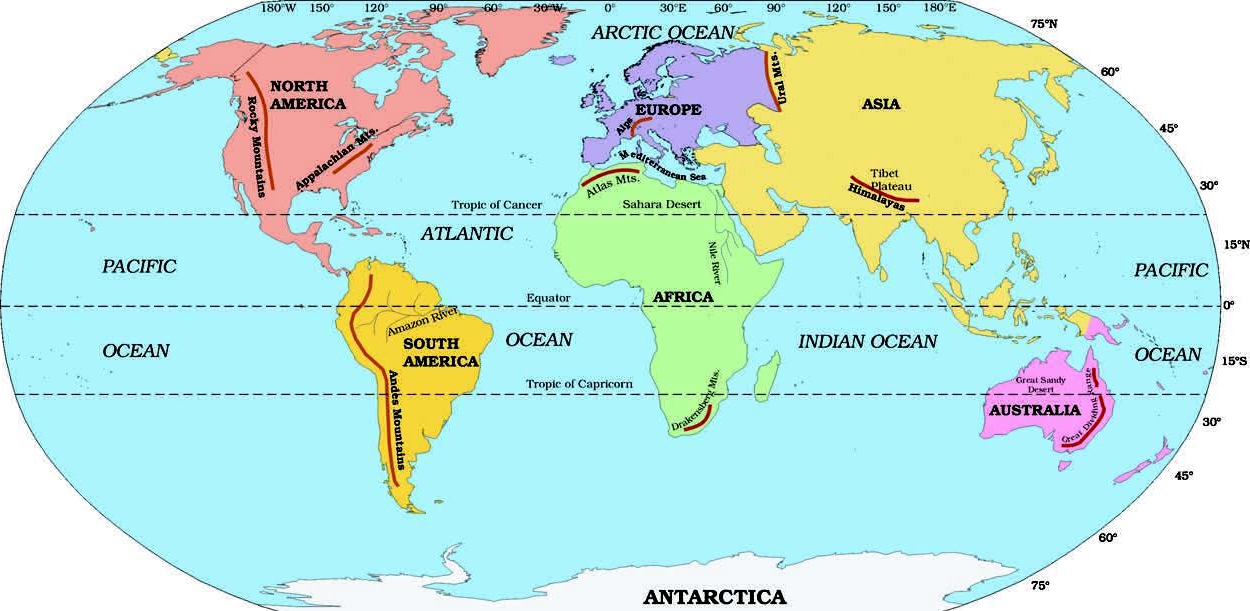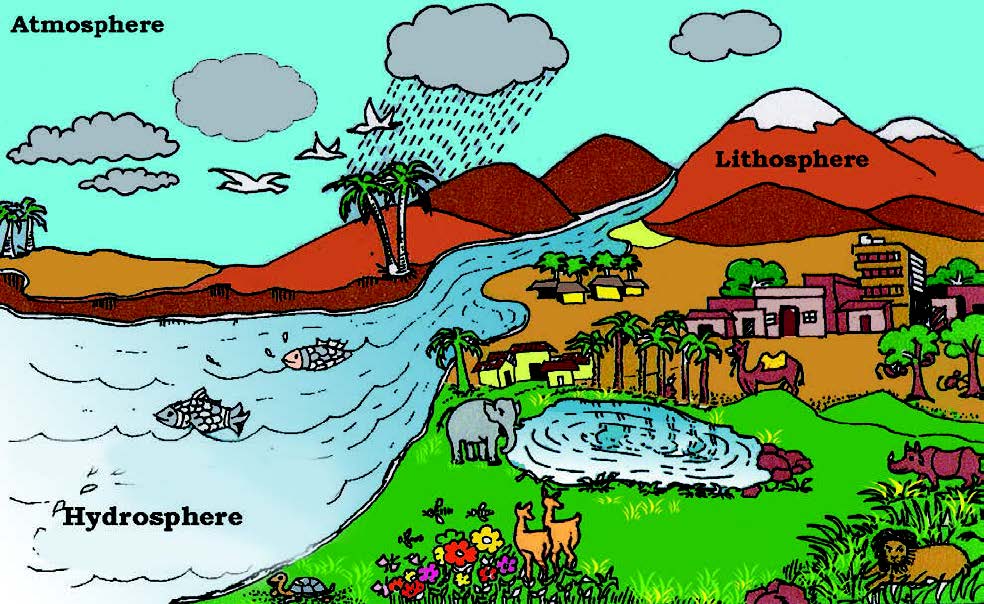Class 6 Geography Major Domains of the Earth chapter 5 notes NCERT Solution in Hindi. NCERT Class 6 Geography Notes, Textual Question Answer and Important Question Answer also Available for Various Board Students like HBSE, CBSE, UP board, Mp Board, RBSE and some other State Boards.
Also Read:- Class 6 Geography NCERT Solution
NCERT Solution for Class 6 Geography Chapter 5 Major Domains of the Earth Notes for students.
Major Domains of the Earth Class 6 Geography Chapter 5 Notes
There are four major domains of the Earth.
1. Lithosphere :- The Solid portion of the earth is called the Lithosphere. It comprises the thin layers of soil and rocks of the earth’s crust. There are two main divisions of earth’s surface one is continents and other one is oceans.
Highest point- Mount Everest 8848m
Greatest depth- Mariana Trench 11022m in pacific ocean
The level of seawater is taken as zero and elevation of land is measured from the level of the sea.
-> Continents :- The large Landmasses are known as the continents. There are seven major continents.
- Asia – It is the largest continent covers one third of total land area and lies in eastern hemisphere. Asia is separated from Europe by Ural Mountains.
- Africa :- It is the 2nd largest continent. The Sahara Desert, the world’s largest how desert is located in Africa. World’s longest river Nile flows through Africa. Through Africa, The Tropic of Cancer, the Equator and the Tropic of Capricorn pass.
- North America :- It is the 3rd largest continent. It is linked to South America by a narrow strip of land called the Isthmus of Panama.
- South America :- The Andes, world’s longest mountain range, runs through this continent. It also has the world’s largest river, the Amazon.
- Antarctica :- It completely lies in Southern Hemisphere. It is permanently covered with thick ice sheets. There are no permanent human settlements. Maitri and Dakshin Gangotri are the research stations of India in Antarctica.
- Europe :- It is bounded by water bodies on three sides. Europe and Asia together is known as Eurasia.
- Australia :- It is the smallest continent lies entirely in the Southern Hemisphere. It is surrounded on all sides by water and therefore is called an island continent.

2. Hydrosphere :- Water covers a very big area of the earth’s surface and this area is called the Hydrosphere. More than 71 percent of the earth is covered with water and therefore earth is called blue planet and 29 percent of earth surface is covered with land. It is stored in the earth in the form of oceans, ice sheets and ground water.
-> Oceans :- More than 97% of the Earth’s water is found in the oceans. There are four major oceans in the world as
- Pacific Ocean :- It is the largest Ocean in the world and spread over one third of the earth. Mariana Trench, the deepest part of the earth, lies under the pacific ocean.
- Atlantic Ocean :- It is the 2nd largest ocean in the world and is S shaped. From the point of view of commerce, it is the busiest Ocean.
- Indian Ocean :- It is triangular in shape and named after the name of India.
- Arctic Ocean :- It is located within Arctic circle . It is connected with the Pacific Ocean by a narrow stretch of shallow water known as Berring Strait.
3. Atmosphere :- The earth is surrounded by a layer of gas called the atmosphere. The atmosphere extends up to a height of about 1,600 Km. The atmosphere is divide into five layers based on composition, temperature and other properties, as the troposphere, the stratosphere, the the mesosphere, the thermosphere and the exosphere. The atmosphere is composed mainly of nitrogen and oxygen of 99% while other gases like carbon dioxide, argon and other gases by 1% in volume. In this 99%, 78% is nitrogen and 21% is oxygen. Oxygen is breath of life while nitrogen helps in growth of living organisms and carbon dioxide absorbs heat radiated by earth, to keep the planet warm. The density of air decreases with increase in height. As a result in mountains climbers experience problems in breathing. The temperature also decreases as we go upwards.
4. Biosphere – The Domain of Life :- It is a narrow zone of contact between the land, water and air. The organisms in biosphere mainly divided into plant kingdom and animal kingdom. The three domains of earth interact with each other and affect in some way or the other.

Global warming :- Increase in the amount of CO2 leads to increase in global temperatures is known as global warming.
Therefore, to maintain the balance of nature between the domains we must need to limit the use of natural resources of earth.
Isthmus :- A narrow strip of land joining two land masses. eg- Panama isthmus that connects North America with South America.
Strait :- A strait is a narrow passage of water connecting two large waterbodies like seas and oceans. eg Palk Strait lies between India and Sri Lanka. It connect Bay of Bengal to Palk bay.